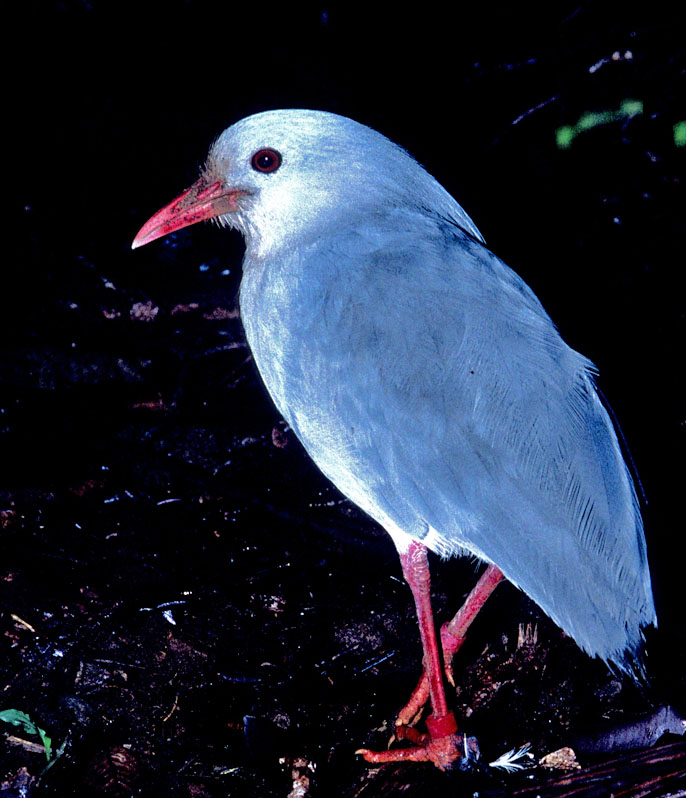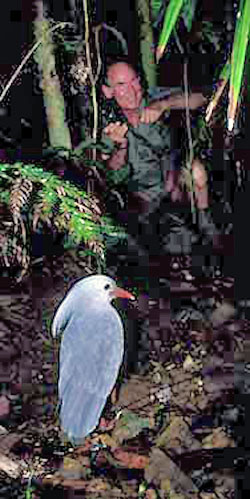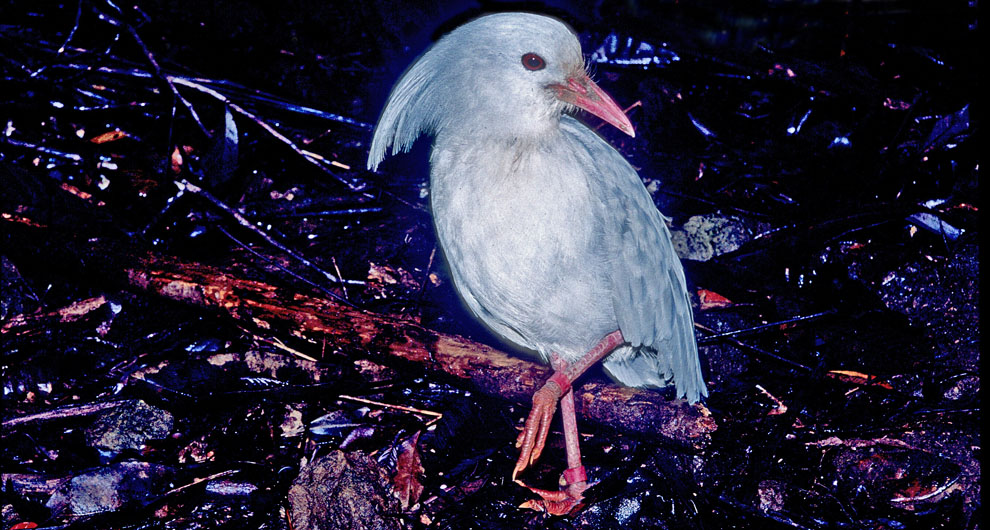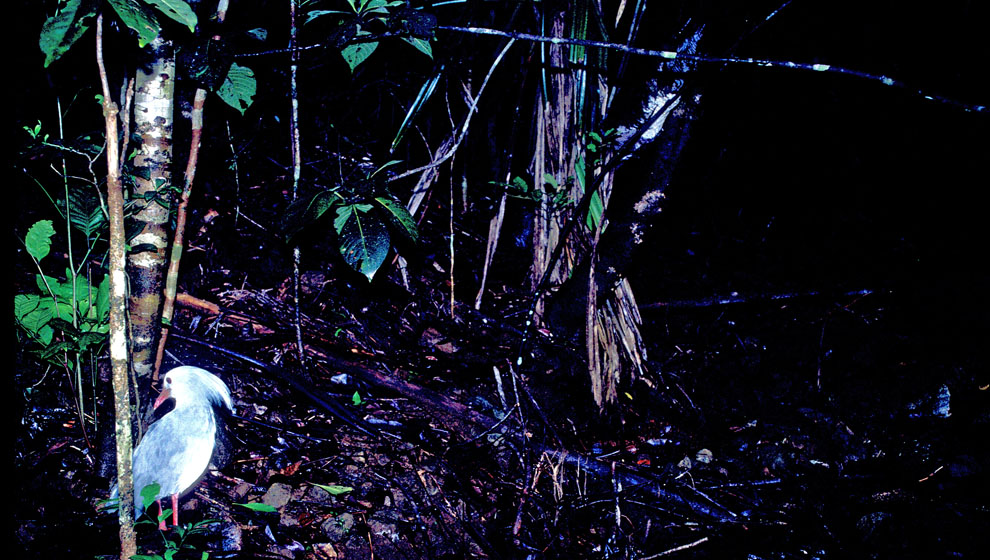| |
KAGU Rhynochetidae |
- 1 species on New Caledonia
- DR personal total: 1 species (100%), 1 photo'd
|
 When I was young, I read that the Kagu, a very unique species in its own family with no close relatives, was "limited to the forested highlands of the island of New Caledonia in the South Pacific, where the native Melanesians knew it long before Europeans arrived. This long-legged, grayish bird, with a startling reddish-orange bill and feet and a pronounced crest on its large head, is barely able to fly. It runs rapidly through the forest underbrush. Generally noisy at night, it has a loud, piercing, yelping cry, almost a scream, that can be heard a mile of more.... Its breeding habitats in the wild have never been studied.... Formerly quite plentiful, the Kagu (photo left) is now in danger of extinction. Much of its forest habitat has been cut off, and Europeans have introduced cats, dogs, pigs, and rats to this island, which formerly had no predatory mammals. If the development of New Caledonia continues, the Kagu will probably survive the century only in captivity;" (Austin & Singer 1961). When I was young, I read that the Kagu, a very unique species in its own family with no close relatives, was "limited to the forested highlands of the island of New Caledonia in the South Pacific, where the native Melanesians knew it long before Europeans arrived. This long-legged, grayish bird, with a startling reddish-orange bill and feet and a pronounced crest on its large head, is barely able to fly. It runs rapidly through the forest underbrush. Generally noisy at night, it has a loud, piercing, yelping cry, almost a scream, that can be heard a mile of more.... Its breeding habitats in the wild have never been studied.... Formerly quite plentiful, the Kagu (photo left) is now in danger of extinction. Much of its forest habitat has been cut off, and Europeans have introduced cats, dogs, pigs, and rats to this island, which formerly had no predatory mammals. If the development of New Caledonia continues, the Kagu will probably survive the century only in captivity;" (Austin & Singer 1961).
New Caledonia is to France what Hawaii is to the United States; a state or province considered an integral part of the primary county. In the 1970s, when I first became interested in birding around the world, I considered this unique bird to be impossible. Not only rare and reclusive, it was said to only be active at night. The only evidence of its existence, it was said, was the bird's night cry, which was played on the national radio station as a sign-off signal. This continued to be the bird's status into the 1980s. Mountfort (1988) summarized: "It is now very localized in those few valleys in the central mountains inaccessible to man. The recent violent conflict over the political future of these islands has resulted in a cessation of logging, hunting and mining. Many Europeans have fled and it is impossible to forecast the future for this splendid bird. It is nominally protected by French law. Plans to create a national park in the Riviére Bleue failed, but a small park was developed near Noumea which provided semi-wild facilities for six pairs of Kagu, which produced 20 juveniles. If the species is to survive, a comprehensive conservation plan is essential. It is listed by the ICBP as Endangered."
By the l990s, I heard that some high-spending listers had been fortunate to see a Kagu in the wild, at night and with a local guide. But in 1997 my friends Arnold Small & Jim Clements visited New Caledonia and, remarkably, found several Kagu during the day — and without a guide — in the Parc du Riviére Bleue, which had been established in recent years at the southern end of the long thin island. They stayed in the capital of Noumea, a coastal town with an Old World feeling. I determined to visit at my first opportunity, which came in January 1998.
|
 The dramatic turn in the fortunes of the Kagu is all due to one man, Yves Letocart (right, with a wild Kagu), now the world's premier authority on the family. Yves has become the world expert on Kagu by hard work and experience, not training. He was born in New Caledonia of a French father and local mother and was a typical teenager, enjoying shooting birds & the introduced pigs, becoming interested in biology only during college. He arrived at Riviére Bleue in 1980. At that time there were only about 60 Kagu left in the remotest parts of the Park. Dogs, cats, stouts and other predators had extirpated them from the Riviére Bleue valley where visitors are allowed. The dramatic turn in the fortunes of the Kagu is all due to one man, Yves Letocart (right, with a wild Kagu), now the world's premier authority on the family. Yves has become the world expert on Kagu by hard work and experience, not training. He was born in New Caledonia of a French father and local mother and was a typical teenager, enjoying shooting birds & the introduced pigs, becoming interested in biology only during college. He arrived at Riviére Bleue in 1980. At that time there were only about 60 Kagu left in the remotest parts of the Park. Dogs, cats, stouts and other predators had extirpated them from the Riviére Bleue valley where visitors are allowed.
Yves instituted a predator trapping and shooting program. In the mid-1980s a captive breeding program was initiated, and in 1989 Yves began radio-collaring birds at his study site to learn the basics of their breeding biology. He found that Kagus form permanent pairs in stable territories (of 30-50 hectares) in dense rainforest. They are flightless, probing in the forest floor for worms, snails and such. Young from prior years help raise this year's chick. Young females leave for new territories when they are 2-3 years old, but young males stay with their parents for years (one banded bird on Yves study site is still with his parents 8 years later).
It was said to be nocturnal but this turned out to be false. Because they actually sleep at night, Yves was able to show some to a few birders in the late 1980s. He had a pen on his study site with captive-bred Kagus which were becoming acclimatized. Wild Kagus were attracted to the captive birds, hanging out near the pen to sleep at night. Yves would take birders out with flashlights to circle the pen, looking for sleeping wild birds. In the early 1990s he was able to take folks to radio-collared birds in the daytime.
When we visited in 1998, it was estimated that about 300 Kagu inhabit Parc du Riviére Bleue, and perhaps 1000 in all of New Caledonia,through releases of captive birds and the predator control program. They have become reestablished in the Riviére Bleue valley itself. Arnold & Jim were perhaps the first American birders to find wild Kagu without Yves' help with radio-collared birds. Arnold & Jim's first pair were at the Great Kaori, a grand kaori tree that towers over the once selectively-logged but otherwise still native forest. That pair was composed of a banded captive-bred male that attracted a wild female and has been living in this territory for about five years.
|
 |
I learned all that background over a couple days with Yves — who had just been promoted to Superintendent of the entire Park. On our first morning with him, we had only driven a couple hundred yards into our first stand of fine native forest when a Kagu ran across the road! Yves slammed on his brakes, hopped out, and began whistling an easily imitated whistle (he said it was the distress call of a young Kagu) and soon a pair of Kagu (unbanded) emerged from the forest and took turns running across the road. Almost too easy!
Later Yves whistled up wild Kagus at the Grand Kaori tree and by the picnic tables, but photography was tough since the birds stayed in dense shade. My flash unit is not really appropriate from my 500mm lens so I was trying using branches as braces and shooting at 1/4 second. But Yves was more than generous. Noting that I still didn't have decent Kagu photos, he invited us back to his house next to his study site in White River valley, off-limits to the public. To get there takes 45 minutes on a 4-wheel-drive-only track, so we climbed into his Suzuki. Yves lives here during the week, returning to his actual home near Noumea on weekends.
During this particular week his wife, Henrietta, was in residence with their three-year-old grand-daughter Anne Marie. Anne Marie wanted to go with us on the Kagu quest, so Yves dressed her in tiny boots, buckled on her tiny knapsack, and handed her a toy binocular. Yves himself suited up with his radio telemetry and located the direction of the nearest Kagu. And we headed up the streambed behind his house into the woods. It was hard going over the fallen logs for the three-year-old, but she was determined and steady. As we got closer, Yves began calling for "his" Kagu, not by whistling, but by simply called "Koghi! Koghi" (pronounced "koo-gee" with a hard "g"). We were standing, calling as one would for a pet dog, when here comes a Kagu running down the hillside to meet us! Banded & wearing the wire of its radio out its lower back, it was a healthy wild male Kagu that Yves first captured and out-fitted eight years ago. It now comes running to his voice in hopes of a hand-out of worms.
Docile and obliging, the Kagu performed — even taking a quick bath in the stream — while I did what a could with my flash and ordinary 35-105mm Nikon zoom lens. Ashamed we hadn't brought Koghi anything, we began digging for worms and those we found were hand-fed to the Kagu by Rita or Anne Marie.
You will note that the Kagu in these shots is banded. This is "Koghi," the wild but habituated Kagu. [If you check out the lead photos in Hunt (1996) you will see the same set of bands.] It was a remarkable experience. We were overwhelmed.
Taxonomically, recent molecular studies found that the the Rhynochetidae is likely the sister family of the Eurypygidae [Sunbittern of the Neotropics]. Fain & Houde (2004) and Ericson et al. (2006) found that the Rhynochetidae does not belong in the Gruiformes but rather in a major, separate radiation of the Neoaves, with Eurypygidae. Currently, these two families together now comprise the Eurypygiformes (Hackett et al. 2008, Suh et al. 2015).
I leave you with the thought of a wild Kagu in the forest of New Caledonia (below), on the rebound and with hope for the future. |
 |
| |
Photos: All of the photos of Kagu Rhynochetos jubatus were taken in the wild in the Parc du Riviére Bleue, New Caledonia, on 8 Jan 1998.
All photos © Don Roberson; all rights reserved.
Bibliographic note: There is no "family book" per se, but a fine introduction to this family, with some good photos, is in Hunt (1996).
Literature cited:
Austin, O. L., and A. Singer. 1961. Birds of the World (edited by H. S. Zim). Golden Press, New York.
Ericson, P.G.P., C.L. Anderson, T. Britton, A. Elzanowski, U.S. Johansson, M. Källersjö, J.I. Ohlson, T.J. Parsons, D. Zuccon, and G. Mayr. 2006. Diversification of Neonaves: integration of molecular sequence data and fossils. Biol. Letters 2: 543–547.
Fain, M. G., and P. Houde. 2004. Parallel radiations in the primary clades of birds. Evolution 58: 2558–2573.
Hackett, S.J., R.T. Kimball, S. Reddy, R.C.K. Bowie, E.L. Braun, M.J. Braun, J.L. Chojnowski, W.A. Cox, K. Han, J. Harshman, C.J. Huddleston, B.D. Marks, K.L. Miglia, W.S. Moore, F.H. Sheldon, D.W. Steadman, C.C. Witt, and T. Yuri. 2008. A phylogenomic study of birds reveals their evolutionary history. Science 320: 1763–1768.
Hunt, G. R. 1996. Family Rhynochetidae (Kagu), pp. 218–225 in Handbook of the Birds of the World (del Hoyo, J., Elliott, A., & Sargatal, J., eds.). Vol. 3. Lynx Edicions, Barcelona.
Mountfort, G. 1988. Rare Birds of the World: A Collins/ICBP Handbook. Stephen Greene Press, Lexington, MA.
Suh, A., L. Smeds, and H. Ellegren. 2015. The dynamics of incomplete lineage sorting across the ancient adaptive radiation of neoavian birds. PLoS Biology 13(8): e1002224 (18 pp.). |
|
|

 The dramatic turn in the fortunes of the Kagu is all due to one man, Yves Letocart (right, with a wild Kagu), now the world's premier authority on the family. Yves has become the world expert on Kagu by hard work and experience, not training. He was born in New Caledonia of a French father and local mother and was a typical teenager, enjoying shooting birds & the introduced pigs, becoming interested in biology only during college. He arrived at Riviére Bleue in 1980. At that time there were only about 60 Kagu left in the remotest parts of the Park. Dogs, cats, stouts and other predators had extirpated them from the Riviére Bleue valley where visitors are allowed.
The dramatic turn in the fortunes of the Kagu is all due to one man, Yves Letocart (right, with a wild Kagu), now the world's premier authority on the family. Yves has become the world expert on Kagu by hard work and experience, not training. He was born in New Caledonia of a French father and local mother and was a typical teenager, enjoying shooting birds & the introduced pigs, becoming interested in biology only during college. He arrived at Riviére Bleue in 1980. At that time there were only about 60 Kagu left in the remotest parts of the Park. Dogs, cats, stouts and other predators had extirpated them from the Riviére Bleue valley where visitors are allowed. 

 When I was young, I read that the Kagu, a very unique species in its own family with no close relatives, was "limited to the forested highlands of the island of New Caledonia in the South Pacific, where the native Melanesians knew it long before Europeans arrived. This long-legged, grayish bird, with a startling reddish-orange bill and feet and a pronounced crest on its large head, is barely able to fly. It runs rapidly through the forest underbrush. Generally noisy at night, it has a loud, piercing, yelping cry, almost a scream, that can be heard a mile of more.... Its breeding habitats in the wild have never been studied.... Formerly quite plentiful, the Kagu (photo left) is now in danger of extinction. Much of its forest habitat has been cut off, and Europeans have introduced cats, dogs, pigs, and rats to this island, which formerly had no predatory mammals. If the development of New Caledonia continues, the Kagu will probably survive the century only in captivity;" (Austin & Singer 1961).
When I was young, I read that the Kagu, a very unique species in its own family with no close relatives, was "limited to the forested highlands of the island of New Caledonia in the South Pacific, where the native Melanesians knew it long before Europeans arrived. This long-legged, grayish bird, with a startling reddish-orange bill and feet and a pronounced crest on its large head, is barely able to fly. It runs rapidly through the forest underbrush. Generally noisy at night, it has a loud, piercing, yelping cry, almost a scream, that can be heard a mile of more.... Its breeding habitats in the wild have never been studied.... Formerly quite plentiful, the Kagu (photo left) is now in danger of extinction. Much of its forest habitat has been cut off, and Europeans have introduced cats, dogs, pigs, and rats to this island, which formerly had no predatory mammals. If the development of New Caledonia continues, the Kagu will probably survive the century only in captivity;" (Austin & Singer 1961).